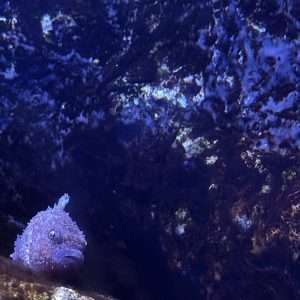5 Things I Learned About Spiny Pacific Lumpsuckers

This tiny, orb-like fish, which only grows 1-3 inches in size, is the aptly named Pacific spiny lumpsucker. Here are 5 things a non-aquarist learned about this interesting species at Greater Cleveland Aquarium.
- Pacific spiny lumpsuckers reside in waters ranging from Northern Japan all the way to the Washington coast in the United States. You’ll find them in shallow bays, rocky reefs, kelp forests and eelgrass beds.
- With a wide mouth and colors ranging from green to brown to plum, lumpsuckers notably lack scales. Instead, the species sports a covering of spiky tubercles. While males typically have reddish-brown outgrowths, females have larger and more-numerous spines with a pale-green coloration.
- When this species reproduces, the eggs are laid in rocky crevices in shallow water. Males care for them, protecting the eggs from predators including crabs, sea stars and small fish.
- Interestingly, lumpsuckers lack a swim bladder and are not very strong swimmers. They rely on their modified pelvic fins to work like a suction cup to help them stay in place, similar to a northern clingfish!
- As less-than-stellar swimmers, lumpsuckers prey upon other slow-moving species like crustaceans, bristle worms and mollusks.
With their striking-yet-small appearance, see how many lumpsuckers you can spot during your next Aquarium visit. Nature. It’s a curious thing.
